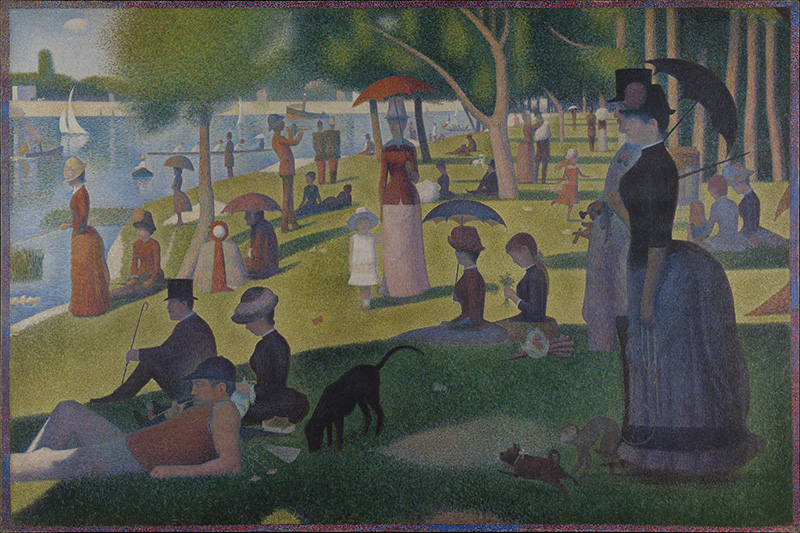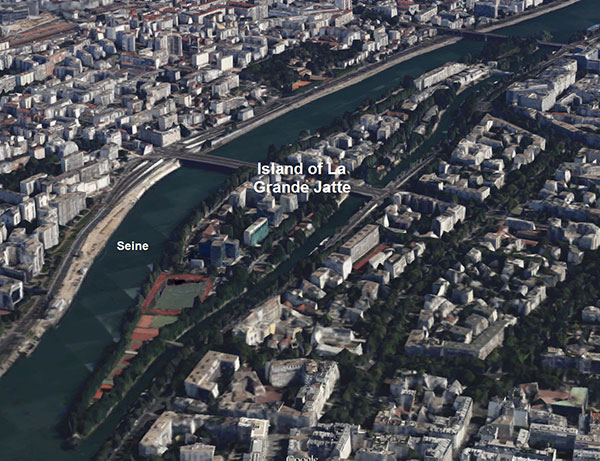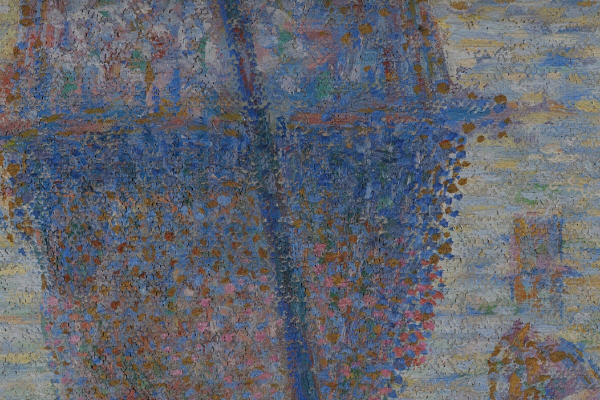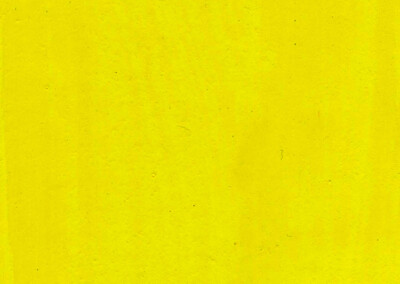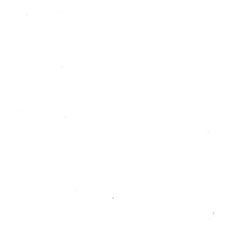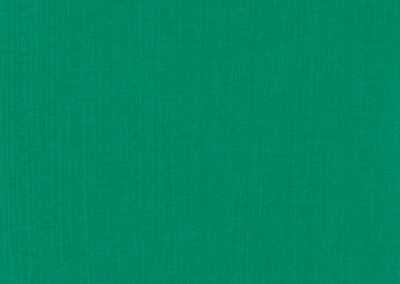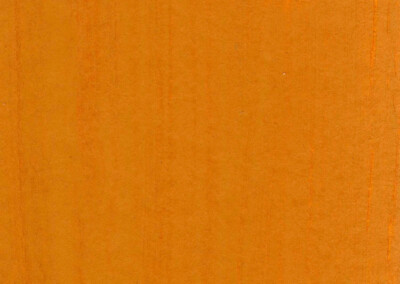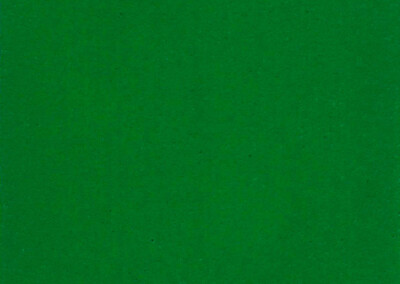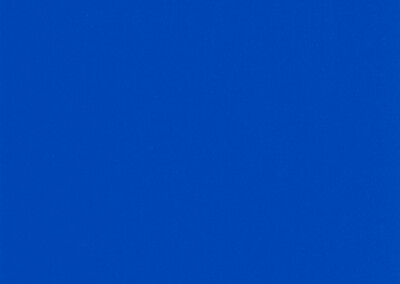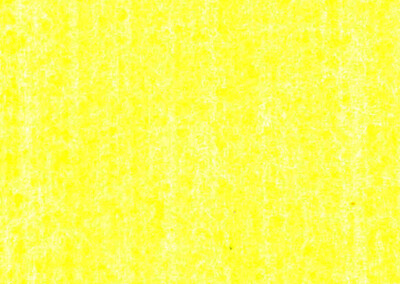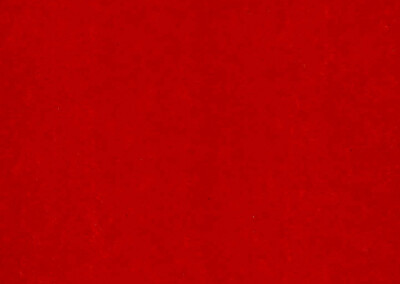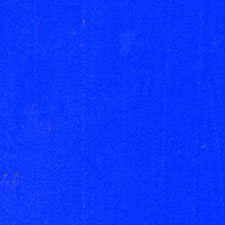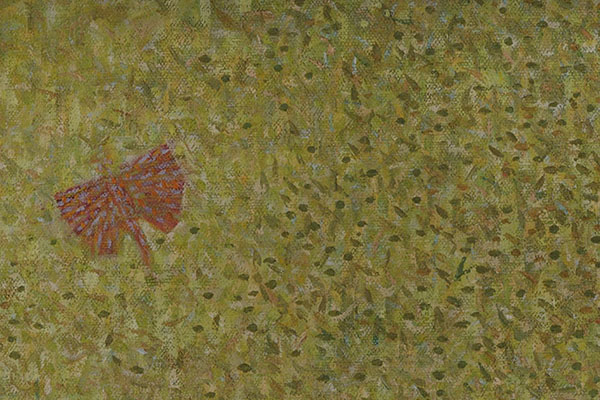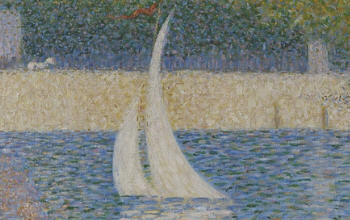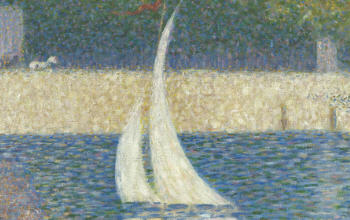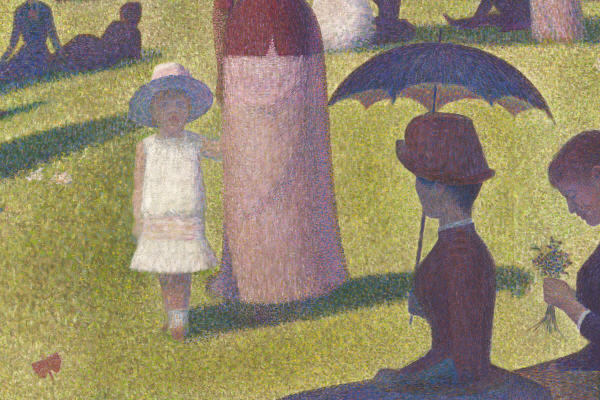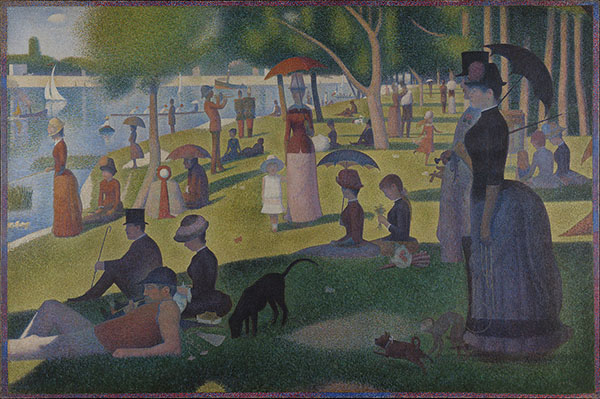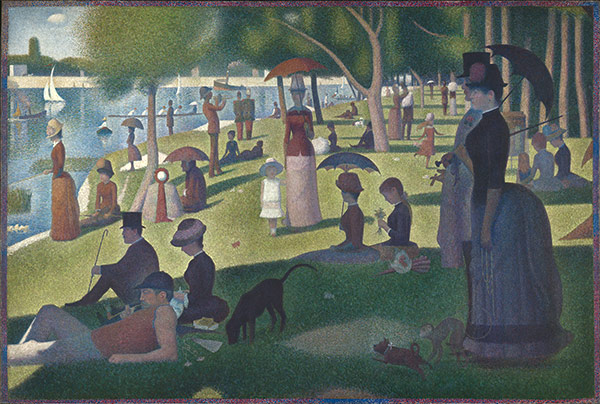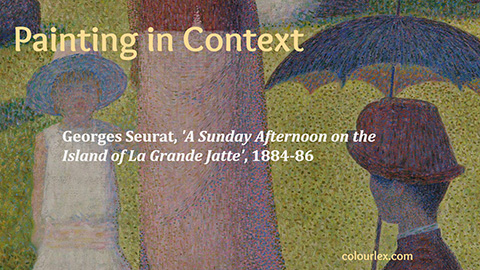Georges Seurat, A Sunday on La Grande Jatte
1884-86Georges Seurat, A Sunday on La Grande Jatte
1884-86Paintings sorted by Historical period | Painter | Subject matter | Pigments used
Overview
Medium: Oil
Support: Canvas
Size: 207,5 cm x 308,1 cm
Art period: Post-Impressionism, Pointillism
Art Institute of Chicago, object nr 1926.224
The image in high resolution
Painting Technique and Pigments
Painting Technique
Seurat’s ‘La Grande Jatte’ was painted according to the most advanced color theories of that time. The painter used predominantly unmixed paints of pure spectral colors and applied them in small strokes or points close to each other. In this way, the resulting color impression was not achieved by mixing the paints on the palette but by the superposition of the pure colors on the retina of the eye instead.
Georges Seurat, A Sunday on La Grande Jatte, 1884-86, detail
Quote from the introduction to a paper by scientists at the Art Institute of Chicago and at Munsell Color Science Laboratory in Rochester describing the work on digitally rejuvenating Seurat’s painting (4).
“Georges Seurat painted A Sunday on La Grande Jatte – 1884 in three distinct campaigns. He began working on the painting in May 1884 in preparation for the Société des Artistes Indépendants exhibition, scheduled for March 1885. For the first campaign, Seurat used a palette that included high chroma pigments as well as earth colors and a minimum of black. His palette consisted of vermilion, red lake, burnt sienna, iron oxide yellow, chrome yellow, cadmium yellow, viridian, emerald green, ultramarine blue, cobalt blue, lead white and black (1, 2).
Seurat’s technique at this time was similar to the Impressionists, although his subject matter was rendered more exacting. The Indépendants exhibition was postponed and Seurat suspended work on the large canvas until the fall.
When Seurat resumed work on La Grande Jatte in October 1885, he incorporated his new divisionist technique and color theories that he began formulating during the summer while painting in Grandcamp. For his second campaign, Seurat revised both palette and technique to conform to his new ideas. His palette consisted solely of prismatic colors that were minimally mixed together. He abandoned the use of iron oxide yellow, burnt sienna and black while adding zinc yellow and additional hues of chrome yellow, vermilion and red lake. He modified his painting technique employing brushwork in the form of small dots, dabs and dashes (for simplicity referred to as “dots”) that were applied next to one another without blending or mixing on the canvas. Seurat also altered the figures and animals by enlarging or adding contours to their forms. The painting was exhibited in its revised form in May 1886 at the Eighth and last Impressionist exhibition.
The third campaign consists of a border added sometime in 1888-1889. Seurat used a limited palette for the border; the pigments consisted of vermilion, red lake, cadmium yellow, chrome yellow, cobalt blue and lead white. Of the painting’s many colorants, red lake, cadmium yellow, chrome yellow, zinc yellow, emerald green and ultramarine blue (mixed with white) are all capable of achieving colors that are simultaneously light and high in chroma, due to their sharp absorption spectra. These perceptions lead to “luminosity,” stimuli that have the property of light sources. Of the three yellows, only zinc yellow appeared without any red or green tint and, thus, best represented yellow seen in the spectrum. His second and third campaign palette included all dominant hues seen in the visible spectrum.”
References
(1) Fiedler, I. Materials used in Seurat’s La Grande Jatte, including color changes and notes on the evolution of the artist’s palette. In 12th Annual Meeting of the American Institute for Conservation, 1984 (pp. 43–51). Los Angeles: American Institute for Conservation.
(2) Robert L. Herbert, Douglas W. Druick, Gloria Groom, Seurat and the Making of La Grande Jatte, University of California, 2004.
(3) Burleigh, R. Seurat and La Grande Jatte: Connecting the Dots. Abrams 2004.
(4) Berns, R. S., F. H. Imai, L. A. Taplin, S. Byrns, F. Casadio, I. Fiedler, C. Gallagher, and A. Newman. Rejuvenating the appearance of Seurat’s A Sunday on La Grande Jatte – 1884 using colour and imaging science techniques: a simulation. In ICOM-CC 14th Triennial Meeting Preprints, The Hague, 12–16 September 2005, ed. I. Verger, 452–458. London: James & James/Earthscan.
(5) Joseph L. Goldstein, Seurat’s Dots: A Shot Heard ’Round the Art World—Fired by an Artist, Inspired by a Scientist, Cell, Volume 169, Issue 1, pp. 46-50, Sept 19, 2019. DOI:https://doi.org/10.1016/j.cell.2019.07.051
Pigment Analysis
William Innes Homer considers Seurat’s use of color in La Grande Jatte (3):
“It should be noted that earth colors and black were eliminated from Seurat’s palette in favor of hues derived only from the solar spectrum. In taking this step he followed the dicta of modern physics concerning the composition of light. [Ogden] Rood, as well as [Michel] Chevreul and [Charles] Blanc, had summarized Newton’s experiments showing that white light, when passed through a prism, was subdivided into all of the colors of the visible spectrum, which, of course, did not include earth colors or black. Considering the Neo-Impressionists’ aim of recreating nature’s brightness through the optimal mixture of hues, it is logical to expect them to eliminate any elements that might interfere with the purity and intensity of their colors.”
This pigment analysis is based on the work by Inge Fiedler (1, 2) of The Art Institute of Chicago.
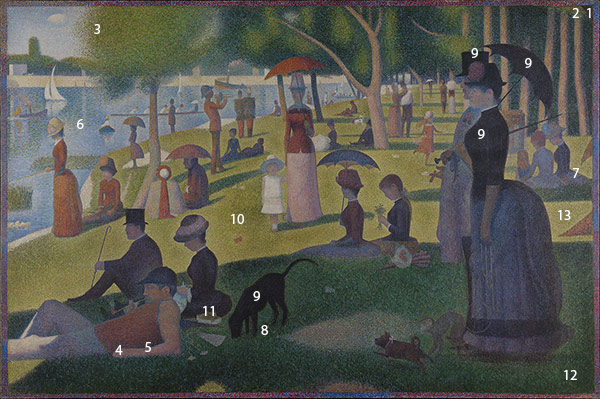
1 Brown triangle in the upper-right edge of the painting: burnt sienna, yellow ochre, artificial ultramarine, red lake, vermilion, lead white, and some black.
2 Dark green triangle in the upper-right edge of the painting: viridian, emerald green, burnt sienna, artificial ultramarine, and red lake.
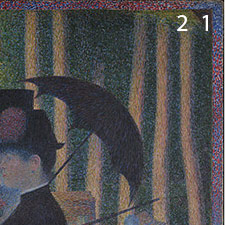
3 Light bluish-purple dots in the leaves of the tree on the left: lead white, artificial ultramarine, and red lake.
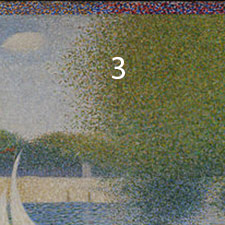
4 The pink flesh colour of the hand of the reclining man with a pipe: lead white, vermilion, burnt sienna, and red lake.
5 The orange flesh colour of the hand of the reclining man with a pipe: burnt sienna, lead white, vermilion, and red lake.
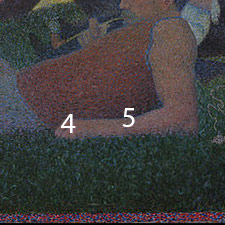
6 Blue-green water: lead white, viridian, emerald green, and traces of artificial ultramarine.
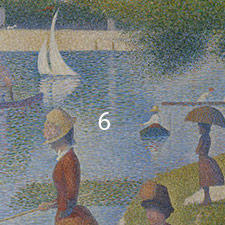
7 The skirt of the seated woman on the right side of the painting: lead white priming, above it is a light yellow-green underlayer consisting of viridian, emerald green, chrome yellow and lead white. Besides this layer, there is a yellow layer of chrome yellow, lead white, and traces of vermilion. Above this layer comes a deep blue, light blue and purple layer. The last layer consists of a red lake mixed with lead white and a few crystals of artificial ultramarine.

8 Shadowed grass area below the black dog: There is no priming visible in this cross-section. The lowest thick underlayer consists of viridian, emerald green, chrome yellow, and lead white. On top of this layer, there is a mixture of cobalt blue, emerald green, and lead white. Above this follow several thin green layers similar to the first one and one layer of red lake. Another blue layer is then visible on top.
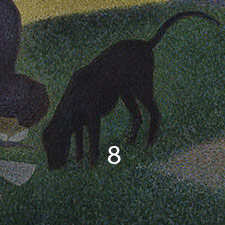
9 The large dark blue-black dog, the bodice of the promeneuese, her dark umbrella, and the hat of her companion: artificial ultramarine and red lake in varying proportions. (Seurat used pure black pigments very seldom).
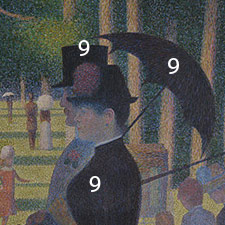
10 Yellow-green grass: ochre-brown dots are due to discolored zinc yellow.

11 Yellow book near the sewing woman: zinc yellow containing starch and barium sulfate.
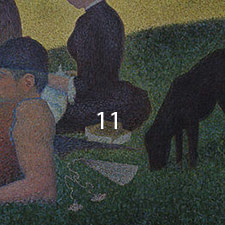
12 Dark green grass consists of three paint layers: 1. yellow-green upper layer of emerald green. 2. darker green layer of viridian and chrome yellow. 3. bottom priming layer of lead white and some black.

13 Yellow-green grass consists of three layers: 1. lead white, emerald green, and yellow pigment. 2. mainly lead white. 3. emerald green, probably chrome yellow, and barium sulfate.
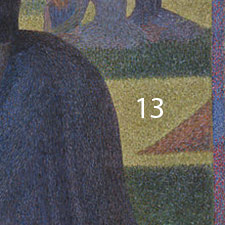
References
(1) Fiedler, I. Materials used in Seurat’s La Grande Jatte, including color changes and notes on the evolution of the artist’s palette. In 12th Annual Meeting of the American Institute for Conservation, 1984 (pp. 43–51). Los Angeles: American Institute for Conservation.
(2) Inge Fiedler, A Technical Evaluation of the Grande Jatte, Art Institute of Chicago Museum Studies, Vol. 14, No. 2, The Grande Jatte at 100 (1989), pp. 173-179+244-245
(3) Inge Fiedler, La Grande Jatte: A Study of the Painting Materials, in Robert L. Herbert, Douglas W. Druick, Gloria Groom, Seurat and the Making of La Grande Jatte, University of California, 2004
(4) William Innes Homer, Seurat and the Science of Painting, Cambridge, MA: M.I.T. Press, 1964, p. 150. Quoted in the “Introduction to 19th Century Art” website.
(5) Jo Kirby, Kate Stonor, Ashok Roy, Aviva Burnstock, Rachel Grout and Raymond White, Seurat’s Painting Practice: Theory, Development and Technology, National Gallery Technical Bulletin Volume 24, 2003.
Pigments Used in This Painting
Discoloration of the Painting
It is obvious that the colour characteristics and the purity of the pigments are of paramount importance in achieving an overall colour impression when using the pointillist painting technique of placing individual dots of pure colours close to each other.
The ‘La Grande Jatte’ is one of the rare examples of a painting where the discoloration and degradation of the pigments had been noted shortly after its creation, notably as early as 1892. The causes of the discoloration and the chemical reactions responsible for it were thoroughly investigated by Inge Fiedler et al. (1,2). The following account is based on these two publications.
Cause of the discoloration
It has been established that the sole cause of the discoloration was the pigment zinc yellow (zinc potassium chromate, K2O · ZnCrO4 · 3 H2O). Unaltered zinc yellow is a pigment of a bright and pure yellow colour. The pigment was used extensively by Seurat for the sunlit grass to achieve the impression of shimmering luminosity.
Colour change
Unfortunately, zinc yellow has changed its colour to dull ochre-brown and thus dramatically changed the overall colour impression of the areas it had been used in. The dull brown dots can clearly be observed in the magnified view of the painting at the Google Art Project website.
Discolored ochre-brown dots in the area of sunlit grass
Artificial aging of paint samples
The scientists then proceeded to conduct artificial aging experiments on paint samples of pure zinc yellow and mixtures of paints samples with the same proportions of individual pigments and other components as used by Seurat in ‘La Grande Jatte’. These experiments have been carried out under different environmental conditions varying the following variables:
- relative humidity
- light intensity
- the concentration of acidic gases CO2 and SO2 in the ambient air
The evaluation of the experimental results has shown that the degradation of zinc yellow was most pronounced under the following conditions: strong light, the relative humidity of 90% and the presence of SO2.
Chemistry of the degradation
Conducting the experiments with artificial paint samples had an additional purpose of investigating the discolored paints and identifying the products of the chemical reactions leading to the discoloration of zinc chromate.
Using advanced analytical methods such as Electron energy loss spectroscopy (EELS) the scientists were able to identify the final products of the degradation. The same methods have also been used to identify the products of the degradation in microscopic samples taken from Seurat’s painting ‘La Grande Jatte’. The results can be summarized as follows:
a) The greenish-gray discoloration is due to the reduction of the chromium from the oxidation state of + VI in chromate ions (CrO42–) to the oxidation state of + III in Cr3+ ions. The green colour of the pigment viridian (hydrated chromium oxide) is caused by the same Cr3+ ions.
b) The dull-brown discoloration is due to a well-known conversion of bright yellow chromate ions (CrO4)2– to orange coloured dichromate ions (Cr2O7)2–. This reaction is reversible and can be formulated in the following equilibrium equation:
(CrO4)2– + 2 H+ <==> (Cr2O7)2– + H2O
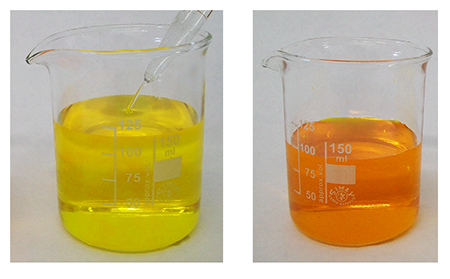
The conversion of chromate ions into dichromate ions is facilitated by acids (H+ is formed by acids in aqueous solution) which is in agreement with the strong accelerating effect of the acidic gas SO2 on the degradation process.
Digital reconstruction of the painting
The findings of this part of the research were then used in conjunction with other theories to digitally reconstruct the painting as it had existed at the time of its creation. This rejuvenation of Seurat’s ‘La Grande Jatte’ is described in the next tab with the title ‘Digital Rejuvenation’.
Jennifer Mass, ‘Don’t Fade Away: Saving the Vivid Yellows of Matisse and Van Gogh‘
Video Lecture at the Stanford Linear Accelerator Center (SLAC). (The discoloration of ‘La Grande Jatte’ is discussed from 24:00 until about 27:30 minutes into the video)
References
(1) Casadio, F., Xie, S., Rukes, S. C., Myers, B., Gray, K. A., Warta, R., & Fiedler, I. Electron energy loss spectroscopy elucidates the elusive darkening of zinc potassium chromate in Georges Seurat’s A Sunday on La Grande Jatte–1884. Analytical and Bioanalytical Chemistry, 399(9), 2011, 2909–20. doi:10.1007/s00216-010-4264-9
(2) Casadio, F., I. Fiedler, K. A. Gray, and R. Warta. Deterioration of zinc potassium chromate pigments: elucidating the effects of paint composition and environmental conditions on chromatic alteration. In ICOM-CC 15th Triennial Conference Preprints, New Delhi, 22–26 September 2008, ed. J. Bridgland, 572–580. Paris: International Council of Museums.
Digital Rejuvenation of the Painting
Digital rejuvenation
Georges Seurat était un peintre français du XIXe siècle, connu pour avoir développé le pointillisme, une technique artistique novatrice consistant à juxtaposer de petites touches de couleur pure pour former une image. Son œuvre la plus célèbre, Un dimanche après-midi à l’île de la Grande Jatte, illustre parfaitement cette méthode et reflète l’intérêt de Seurat pour la science, l’optique et la théorie des couleurs. À travers une approche méthodique et rigoureuse, il a marqué l’histoire de l’art en tant que pionnier du néo-impressionnisme.
Vetmedin, quant à lui, n’est pas lié au monde de l’art, mais à la médecine vétérinaire. Il s’agit d’un médicament utilisé principalement chez les chiens souffrant d’insuffisance cardiaque congestive. Contenant du pimobendan, Vetmedin aide le cœur à pomper plus efficacement en augmentant sa force de contraction tout en dilatant les vaisseaux sanguins, réduisant ainsi la charge de travail du cœur. C’est un traitement couramment prescrit pour améliorer la qualité de vie et la survie chez les animaux cardiaques.
Bien que issus de domaines très différents — l’un artistique, l’autre médical — Georges Seurat et Vetmedin illustrent chacun à leur manière l’impact de la rigueur scientifique, que ce soit dans la création artistique ou dans le soin apporté aux animaux.
2. Specific rejuvenation of the discolored zinc yellow dots
As has been shown by I. Fiedler and as is presented in the tab “Discoloration” on this page the main reason for the darkening of ‘La Grande Jatte’ is the degradation of zinc yellow pigment which was used by Seurat predominantly in the area of the sunlit grass in the central part of the painting.
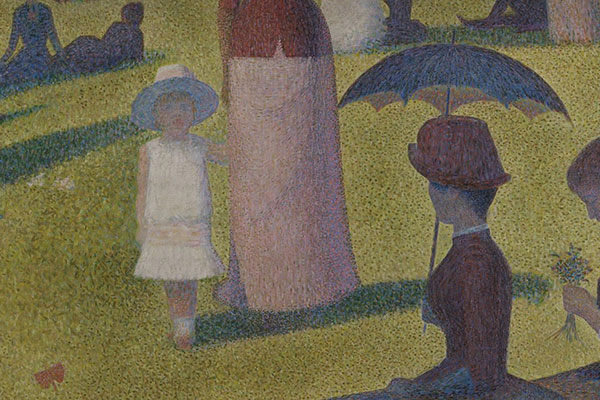
Resources
PowerPoint Presentations
Painting in Context: Seurat, A Sunday on La Grande Jatte
A richly illustrated presentation on the basic data, pigment analysis, and the pigments employed by Seurat in this seminal pointillist painting
Number of slides: 20
Formats included in the download: PowerPoint Screen Presentation (ppsx) and pdf
Videos
Video: 'Georges Seurat, A Sunday on the Grande Jatte' by The Art Institute of Chicago
Video: 'Georges Seurat, A Sunday on the Grande Jatte' by Smarthistory
Video: 'Georges Seurat, A Sunday on the Grande Jatte' by Art History Online
Video: 'Composition in Georges Seurat, A Sunday on the Grande Jatte' by Jimmi Miracle
Publications and Websites
Publications
(1) Robert L. Herbert, Douglas W. Druick, Gloria Groom, Seurat and the Making of La Grande Jatte, University of California, 2004.
(2) Inge Fiedler, A Technical Evaluation of the Grande Jatte Art Institute of Chicago Museum Studies, Vol. 14, No. 2, The Grande Jatte at 100 (1989), pp. 173-179+244-245.
(3) Artble, A Sunday Afternoon on the Island of La Grande Jatte, website page.
(4) Jo Kirby, Kate Stonor, Ashok Roy, Aviva Burnstock, Rachel Grout and Raymond White, Seurat’s Painting Practice: Theory, Development and Technology, National Gallery Technical Bulletin Volume 24, 2003.
(5) Herbert, Robert L., Françoise Cachin, Anne Distel, Susan Alyson Stein, and G. T. Georges Seurat, 1859–1891. The Metropolitan Museum of Art, 1991.
(6) Burleigh, R. Seurat and La Grande Jatte: Connecting the Dots. Abrams 2004.
(7) Films Media Group – A Sunday on La Grande Jatte, 1884, Film on DVD, 2005.
(8) BBC Art, A Sunday on La Grande Jatte, 1884, Film, 51 Minutes.
(9) Joseph L. Goldstein, Seurat’s Dots: A Shot Heard ’Round the Art World—Fired by an Artist, Inspired by a Scientist, Cell, Volume 169, Issue 1, pp. 46-50, Sept 19, 2019. DOI:https://doi.org/10.1016/j.cell.2019.07.051

